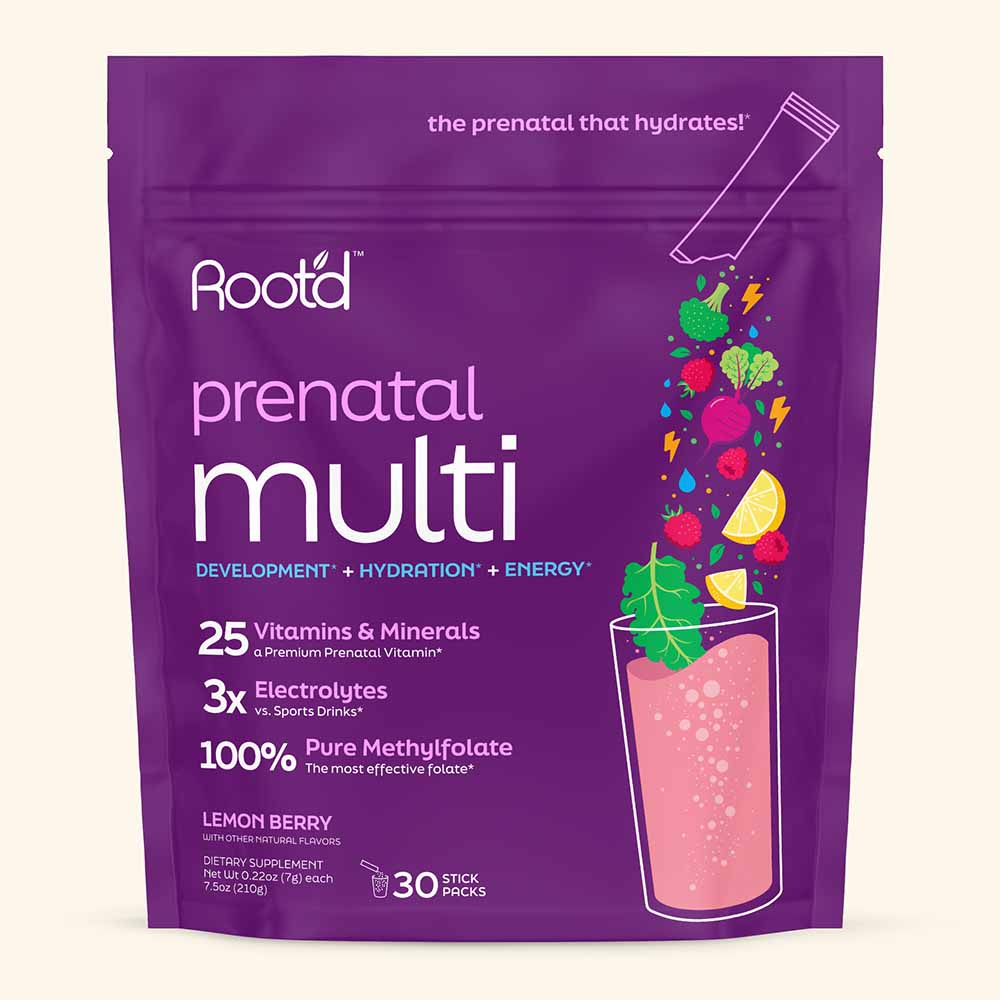 Vitamin A
Vitamin A
| Amount Per Serving |
900 mcg |
| %DV |
100% |
Vitamin A
Daily Requirements (By FDA):
Adults (Men/Women): 900 mcg. Pregnant/Lactating Women: 1300 mcg. Children 1-3: 300mcg[1]
Top 3 Food Sources:
Carrots (900mcg=5.4oz), Tuna (900mcg=4.3oz), Sweet Potato (900mcg=3.oz) [3]
Deficiency Symptoms:
Rare* - Dry skin/eyes*, Night Blindness*, More prone to infections esp. in throat/chest*. [2] [4]
Supplement Forms (& Cost):
1. retinyl acetate – Synthetic $
2. retinyl palmitate (preformed vitamin A) $$. 3. beta-carotene (provitamin A) $$ [2]
 Sources both retinyl palmitate & beta-carotene to help maximize effectiveness*
Sources both retinyl palmitate & beta-carotene to help maximize effectiveness*
Key Functions of Vitamin A:
Vision*, Immune Support*, Organ Health*. [2]
 Vitamin C
Vitamin C
| Amount Per Serving |
90 mg |
| %DV |
100% |
Vitamin C
Daily Requirements (By FDA):
Adults (Men/Women): 90 mg. Pregnant/Lactating Women: 120 mg. Children 1-3: 15 mg[1]
Top 3 Food Sources:
Cantaloupe, Citrus Fruits, Dark Leafy Greens/Broccoli[6]
Deficiency Symptoms:
Rare* - Weakness*, Muscle Joint Pain*, Easy Bruising*, Scurvy* [7]
Common Supplement Forms (& Cost):
1. Ascorbic Acid $
2. sodium ascorbate $.
3 calcium ascorbate$ [5]
 Sources Ascorbic Acid, although research has not shown one form to be better than other forms*[5]
Sources Ascorbic Acid, although research has not shown one form to be better than other forms*[5]
Key Functions of Vitamin C:Antioxidant*, Immune Support*, Helps Heal Wounds* [5]
 Vitamin D
Vitamin D
| Amount Per Serving |
60 mcg |
| %DV |
300% |
Vitamin D
Daily Requirements (By FDA):
Adults (Men/Women): 20 mcg. Pregnant Women: 15 mcg.
Top 3 Food Sources:
Sunshine, Mushrooms (Fungi), & Fatty Fish
Deficiency Symptoms:
Numerous – Weakened immune system*, Fatigue*, bone or joint pain*, bone loss (osteoporosis)*, muscle pain*, depression*.
Supplement Forms (& Cost):
1. Vitamin D2 (ergocalciferol) – plant sourced. - $$$
2. Vitamin D3 (cholecalciferol) – Animal sourced
 Sources cholecalciferol as overwhelming evidence from studies show better absorption rates in the body.*[5]- $$
Sources cholecalciferol as overwhelming evidence from studies show better absorption rates in the body.*[5]- $$
DIVE DEEPER
Key Functions of Vitamin D:
Bone Health*, Immune Health*, Aids in carrying messages between brain and body parts*.
 Vitamin E
Vitamin E
| Amount Per Serving |
15 mg |
| %DV |
100% |
Vitamin E
Daily Requirements (By FDA):
Adults (Men/Women): 15 mg. Pregnant/Lactating Women: 19 mg. Children 1-3: 6 mg[1]
Top 3 Food Sources:
Sunflower Seeds, Almonds, Dark Leafy Greens [9]
Deficiency Symptoms:
Rare* - Vision Impairment, Nerve Damage in hands/feet, Decreased Immune Function* [9]
Common Supplement Forms (& Cost):
1. dl-alpha-tocopherol acetate – Synthetic form $
2. d-alpha-tocopherol succinate – Natural Form $$. [8]
 Sources d-alpha-tocopherol succinate, as it is a natural, more potent form of Vitamin E *[8]
Sources d-alpha-tocopherol succinate, as it is a natural, more potent form of Vitamin E *[8]
Key Functions of Vitamin E:
Natural antioxidant*, skin cell health* [8]
 Vitamin B1
Vitamin B1
| Amount Per Serving |
1.2 mg |
| %DV |
100% |
Vitamin B1
Daily Requirements (By FDA):
Adults (Men/Women): 1.2 mg. Pregnant/Lactating Women: 1.4 mg. Children 1-3: 0.5 mg[1]
Top 3 Food Sources:
Whole Grains, Pork, Legumes [11]
Deficiency Symptoms:
Rare* - Weight Loss*, Confusion/Memory Loss*, Muscle Weakness*, Lowered Immunity* [11]
Common Supplement Forms (& Cost):
1. Benfotiamine - Synthetic $
2. Thiamin– Natural $$. [8]
 Sources thiamin, as it is a well-studied natural source derived from food sources.* [10]
Sources thiamin, as it is a well-studied natural source derived from food sources.* [10]
Key Functions of Vitamin B1:
Enables carbohydrates to convert to energy*, also aids in nerve, muscle, & heart function*[12]
 Vitamin B2
Vitamin B2
| Amount Per Serving |
1.3mg |
| %DV |
100% |
Vitamin B2
Daily Requirements (By FDA):
Adults (Men/Women): 1.3 mg. Pregnant/Lactating Women: 1.6 mg. Children 1-3: 0.5 mg[1]
Top 3 Food Sources:
Beef Liver, Oatmeal, Fortified Foods [13]
Deficiency Symptoms:
Mouth ulcers*, cracked lips*, dry skin*, anemia*, sore throat*. [14]
Common Supplement Forms (& Cost):
1. Riboflavin – Natural $
2. Riboflavin 5'-Phosphate – Natural $$$. [14]
 Sources Riboflavin, as it is a well-studied natural source derived from food sources.* [14]
Sources Riboflavin, as it is a well-studied natural source derived from food sources.* [14]
Key Functions of Vitamin B2:
Helps breakdown carbohydrates, proteins, and fats*. Vital to body’s energy supply*. Excess/non-used B2 can cause “yellow pee”, which is in itself harmless*[14]
 Vitamin B3 (Niacin)
Vitamin B3 (Niacin)
| Amount Per Serving |
16 mg |
| %DV |
100% |
Vitamin B3 (Niacin)
Daily Requirements (By FDA):
Adults (Men/Women): 16 mg. Pregnant/Lactating Women: 18 mg. Children 1-3: 6 mg[1]
Top 3 Food Sources:
Beef Liver, Poultry, Brown Rice[16]
Deficiency Symptoms:
Memory Loss & Mental Confusion*, Fatigue*, Depression*, Skin Problems* [15] [16]
Common Supplement Forms (& Cost):
1. Nicotinic acid– Synthetic $
2. Nicotinamide – Natural $$. [15] [16]
 Sources Nicotinamide , as Nicotinic acid is known to cause skin flushing or “Nacin Flashes”, while Nicotinamide does not.* [16] [17]
Sources Nicotinamide , as Nicotinic acid is known to cause skin flushing or “Nacin Flashes”, while Nicotinamide does not.* [16] [17]
Key Functions of Vitamin B3 (Niacin):Helps turn food into energy, aids in digestive system*, and helps keep skin healthy*[15]
 Vitamin B5 (Pantothenic Acid)
Vitamin B5 (Pantothenic Acid)
| Amount Per Serving |
5 mg |
| %DV |
100% |
Vitamin B5 (Pantothenic Acid)
Daily Requirements (By FDA):
Adults (Men/Women): 5 mg. Pregnant/Lactating Women: 7 mg. Children 1-3: 2 mg[1]
Top 3 Food Sources:
Beef Liver, Shitake Mushrooms, Avocados [19]
Deficiency Symptoms:
Burning and numbness in feet and hands*, fatigue*, headache* [19]
Common Supplement Forms (& Cost):
1. Pantothenol $
2. Calcium Pantothenate $. [18] [19]
 Sources calcium pantothenate, as it is a well-studied safe form, although little research exists noting differences in absorbability between the different forms* [18]
Sources calcium pantothenate, as it is a well-studied safe form, although little research exists noting differences in absorbability between the different forms* [18]
Key Functions Vitamin B5 (Pantothenic Acid):
Helps turn food into energy, necessary for making blood cells*, Helps aid metabolism*[18]
 Vitamin B6
Vitamin B6
| Amount Per Serving |
1.7 mg |
| %DV |
100% |
Vitamin B6
Daily Requirements (By FDA):
Adults (Men/Women): 1.7 mg. Pregnant/Lactating Women: 2 mg. Children 1-3: 0.5 mg[1]
Top 3 Food Sources:
Beef Liver, Yellowfin Tuna, Chickpeas [20]
Deficiency Symptoms:
Skin conditions*, Depression*, Impaired Immunity* [20]
Common Supplement Forms (& Cost):
1. Pyridoxine Hydrochloride (HCI) $
2. Pyridoxine-5-Phosphate[20] [21]
 Sources a combination of the two forms, as each are well researched, and using both may help increase absorption rates* [21]
Sources a combination of the two forms, as each are well researched, and using both may help increase absorption rates* [21]
Key Functions of Vitamin B6:
Brain performance*, Helps with nausea during pregnancy*. [20]
 Vitamin B7 (Biotin)
Vitamin B7 (Biotin)
| Amount Per Serving |
120 mcg |
| %DV |
400% |
Vitamin B7 (Biotin)
Daily Requirements (By FDA):
Adults (Men/Women): 30 mcg. Pregnant/Lactating Women: 35 mcg. Children 1-3: 8 mcg [1]
Top 3 Food Sources:
Beef Liver, Eggs, Sweet Potato [23]
Deficiency Symptoms:
Hair loss*, Rash formation*, Depression*. [22]
Common Supplement Forms (& Cost):
1. Biotin [23]
 Sources Biotin, as it is the only supplement form of this nutrient with extremely high absorption rates nearing 100% [23]
Sources Biotin, as it is the only supplement form of this nutrient with extremely high absorption rates nearing 100% [23]
Key Functions of Biotin:
Important for health of hair, skin, & Nails*, helps the body convert food to energy*[22,23]
 Vitamin B9 (Folate)
Vitamin B9 (Folate)
| Amount Per Serving |
400 mcg DFE |
| %DV |
100% |
Vitamin B9 (Folate)
Daily Requirements (By FDA):
Adults (Men/Women): 400 mg. Pregnant/Lactating Women: 600 mg. Children 1-3: 150 mg [1]
Top 3 Food Sources:
Leafy Greens (Kale), Brussel Sprouts, Beef [47]
Deficiency Symptoms:
Weakness*, Fatigue*, headache*, trouble concentrating*, and in pregnant women, can cause neural tube defects*. [47]
Common Supplement Forms (& Cost):
1. Folic Acid - $
2. Methylfolate (5-MTHF) - $$$$ [45]
 sources 100% Methylfolate, as it is the more active and natural form of folate. It also ensures absorbency, as many people are unable to absorb Folic Acid*[47, 48]
sources 100% Methylfolate, as it is the more active and natural form of folate. It also ensures absorbency, as many people are unable to absorb Folic Acid*[47, 48]
Key Functions of Folate:
Needed to make DNA, and to help cells divide. During pregnancy, folate helps develop the neural tube. [47]
 Vitamin B12
Vitamin B12
| Amount Per Serving |
40 mcg |
| %DV |
1,667% |
Vitamin B12
Daily Requirements (By FDA):
Adults (Men/Women): 2.4 mcg. Pregnant/Lactating Women: 2.8 mcg. Children 1-3: 0.9 mcg[1]
Top 3 Food Sources:
Mushrooms, Nutritional Yeast, Seaweed [24]
Deficiency Symptoms:
Nervous system issues*, anxiety*, depression*, vision loss* [24]
Common Supplement Forms (& Cost):
1. Cyanocobalamin -$
2. Hydroxycobalamin - $
3. Methylcobalamin [25]
 Sources Methylcobalamin as it is the natural from used by the body, and multiple studies suggest the body absorbs and retains it better than other sources* [25]
Sources Methylcobalamin as it is the natural from used by the body, and multiple studies suggest the body absorbs and retains it better than other sources* [25]
DIVE DEEPER
Key Functions of Vitamin B12:
Helps the body make DNA*, aids body’s nerve and blood cell health*.[25]
 Calcium
Calcium
| Amount Per Serving |
39 mg |
| %DV |
3% |
Calcium
Daily Requirements (By FDA):
Adults (Men/Women): 1300 mg. Pregnant/Lactating Women: 1300 mg. Children 1-3: 700 mg[1]
Top 3 Food Sources:
Dairy foods, Fortified Foods, Legumes [26]
Deficiency Symptoms:
Short term symptoms are not obvious as the body takes calcium from the bones if not present from digestion*. Long term leads to low bone mass* or osteoporosis* [27]
Common Supplement Forms (& Cost):
1. Calcium Carbonate -$
2. Calcium Citrate - $$
3. Calcium Lactate $$ [25]
 Sources Calcium Lactate as it, along with Calcium Citrate, show higher absorption rates, and also dissolves well when mixed with liquids [27]
Sources Calcium Lactate as it, along with Calcium Citrate, show higher absorption rates, and also dissolves well when mixed with liquids [27]
Key Functions of Calcium:
Bone Health*, allows muscles to contract*.[26]
 Iron
Iron
| Amount Per Serving |
9 mg |
| %DV |
50% |
Iron
Daily Requirements (By FDA):
Adults (Men/Women): 18 mg. Pregnant/Lactating Women: 27 mg. Children 1-3: 7 mg[1]
Top 3 Food Sources:
Spinach, Lean meats, Kidney Beans [28]
Deficiency Symptoms:
Short term symptoms are not obvious as the body takes iron from the muscles or organs if not present from digestion*. Long term leads to lack of energy or anemia*. [28]
Common Supplement Forms (& Cost):
1. Ferrous Fumarate -$
2. Carbonyl Iron - $
3. Ferrous Bisglycinate Chelate - $$ [28]
 Sources Ferrous Bisglycinate Chelate as it is the MOST gentle form of iron, and other forms can cause upset stomach, and constipation, especially in pregnant women*. [28]
Sources Ferrous Bisglycinate Chelate as it is the MOST gentle form of iron, and other forms can cause upset stomach, and constipation, especially in pregnant women*. [28]
Key Functions of Iron:
Helps to make hemoglobin, a protein in red blood cells*, helps make certain hormones* [28]
*BE AWARE - Accidental overdose of iron-containing products is a leading cause of fatal poisoning in children under 6.
*BE AWARE – Adult men should not supplement with Iron unless directed to by a doctor, as men do not menstruate*.  Men’s formulas do not contain iron for this reason.
Men’s formulas do not contain iron for this reason.
 Iodine
Iodine
| Amount Per Serving |
150 mcg |
| %DV |
100% |
Iodine
Daily Requirements (By FDA):
Adults (Men/Women): 150 mcg. Pregnant/Lactating Women: 290 mcg. Children 1-3: 90 mcg [1]
Top 3 Food Sources:
Seaweed, Iodized Salt, Tuna [29]
Deficiency Symptoms:
Thyroid malfunction*. In pregnant women deficiency can harm the fetus and cause stunted growth, intellectual disability, or delayed sexual development*. [29]
Common Supplement Forms (& Cost):
1. Sodium Iodide - $
2. Kelp - $
3. potassium iodide - $[23]
 Sources potassium iodide, as it mixes extremely well in liquids without adding seafood flavors/aromas. There is little research showing absorbability differences between the three options. [29]
Sources potassium iodide, as it mixes extremely well in liquids without adding seafood flavors/aromas. There is little research showing absorbability differences between the three options. [29]
Key Functions of Iodine:
Helps the body make thyroid hormones*, helps control body's metabolism*.[29]
 Magnesium
Magnesium
| Amount Per Serving |
21 mg |
| %DV |
5% |
Magnesium
Daily Requirements (By FDA):
Adults (Men/Women): 420 mg. Pregnant/Lactating Women: 400 mg. Children 1-3: 80 mg [1]
Top 3 Food Sources:
Quinoa, Nuts/Seeds, Dark Chocolate [31]
Deficiency Symptoms:
Estimated 80% of Americans are deficient in Magnesium. Fatigue, stiff/cramped muscles, high blood pressure, numbness* [30, 31]
Common Supplement Forms (& Cost):
1. Magnesium Oxide - $
2. Magnesium Citrate - $$
3. Magnesium Glycinate - $$ [30]
 Sources Magnesium Citrate, as it mixes extremely well in liquids, and has well researched high absorption rates*. Too much magnesium at one time can cause a laxative effect*, so we do not use 100%. Magnesium Oxide in particular has shown to have lower absorption rates*, and can increase the laxative effect. [30, 31] Be aware of any mineral ending with the word “oxide”, as these are very cheap forms.
Sources Magnesium Citrate, as it mixes extremely well in liquids, and has well researched high absorption rates*. Too much magnesium at one time can cause a laxative effect*, so we do not use 100%. Magnesium Oxide in particular has shown to have lower absorption rates*, and can increase the laxative effect. [30, 31] Be aware of any mineral ending with the word “oxide”, as these are very cheap forms.
Key Functions of Magnesium:
Regulates muscle and nerve function*, blood sugar levels*, blood pressure*, and stress*.[30]
 Zinc
Zinc
| Amount Per Serving |
2.5 mg |
| %DV |
23% |
Zinc
Daily Requirements (By FDA):
Adults (Men/Women): 11 mg. Pregnant/Lactating Women: 13 mg. Children 1-3: 3 mg [1]
Top 3 Food Sources:
Shellfish (Oysters/Lobster/Crab), Nuts/Seeds, Whole Grains [32]
Deficiency Symptoms:
Lowered immune function, diarrhea, impaired ability to heal wounds.* [32, 33]
Common Supplement Forms (& Cost):
1. Zinc Oxide - $
2. Zinc acetate - $
3. Zinc citrate - $$ [32]
 Sources Zinc Citrate, as it mixes extremely well in liquids, and has well researched high absorption rates*. Too much zinc at one time can cause nausea*, so we do not use 100%. Zinc Oxide in particular has shown to have lower absorption rates*, and can increase the nausea effect. [32, 33] Be aware of any mineral ending with the word “oxide”, as these are very cheap forms.
Sources Zinc Citrate, as it mixes extremely well in liquids, and has well researched high absorption rates*. Too much zinc at one time can cause nausea*, so we do not use 100%. Zinc Oxide in particular has shown to have lower absorption rates*, and can increase the nausea effect. [32, 33] Be aware of any mineral ending with the word “oxide”, as these are very cheap forms.
Key Functions of Zinc:
Helps immune system fight off invading bacteria and viruses*, helps the body make proteins and DNA*.[32]
 Selenium
Selenium
| Amount Per Serving |
30 mcg |
| %DV |
55% |
Selenium
Daily Requirements (By FDA):
Adults (Men/Women): 55 mcg. Pregnant/Lactating Women: 70 mcg. Children 1-3: 20 mcg [1]
Top 3 Food Sources:
Seafood, Beef Liver, Brazil Nuts [46]
Deficiency Symptoms:
Thyroid problems, iodine deficiency, infertility, immune issues, and frequent illness [45, 46]
Common Supplement Forms (& Cost):
1. Selenomethionine - $
2. Sodium Selenate- $
3. Selenium Glycinate- $ [45]
 sources Selenium Glycinate, as it is one of most bioavailable well researched forms of Selenium [45]
sources Selenium Glycinate, as it is one of most bioavailable well researched forms of Selenium [45]
DIVE DEEPER
Key Functions of Selenium:
Needed to keep the body healthy*. Selenium is important for reproduction, DNA production, thyroid gland function, and aids your immune system by protecting the body from damage cause by free radicals and infections.
 Manganese
Manganese
| Amount Per Serving |
0.5 mg |
| %DV |
22% |
Manganese
Daily Requirements (By FDA):
Adults (Men/Women): 2.3 mg. Pregnant/Lactating Women: 2.6 mg. Children 1-3: 1.2 mg [1]
Top 3 Food Sources:
Shellfish (Oysters/Lobster/Crab), Pineapple, Whole Grains [34]
Deficiency Symptoms:
Lowered immune function, skin rashes, loss of hair color (in men), increased premenstrual pain and mood changes (in women)*. [34]
Common Supplement Forms (& Cost):
1. Manganese Sulfate - $
2. Manganese aspartate- $
3. Manganese citrate - $$ [34]
 Sources Manganese Citrate, as it mixes extremely well in liquids, and has well researched high absorption rates*. [34]
Sources Manganese Citrate, as it mixes extremely well in liquids, and has well researched high absorption rates*. [34]
Key Functions of Manganese:
Helps the body produce energy and protects cells from damage, critical in helping initiate immune responses*.[34, 35]
 Copper
Copper
| Amount Per Serving |
0.3 mg |
| %DV |
33% |
Copper
Daily Requirements (By FDA):
Adults (Men/Women): 0.9 mg. Pregnant/Lactating Women: 1.3 mg. Children 1-3: 0.3 mg [1]
Top 3 Food Sources:
Shellfish (Oysters/Lobster/Crab), Potatoes, Organ Meets [37]
Deficiency Symptoms:
Anemia, connective tissue disorders, bone defects, and increased risk of infection*. [37]
Common Supplement Forms (& Cost):
1. cupric oxide - $
2. copper gluconate - $
3. copper amino acid chelates - $ [37]
 Sources copper amino acid chelates, as it is a well-studied natural form, although there is little evidence of a difference between absorption rates from the different forms*. [37]
Sources copper amino acid chelates, as it is a well-studied natural form, although there is little evidence of a difference between absorption rates from the different forms*. [37]
Key Functions of Copper:
Helps the body form red blood cells*. Also helps maintain healthy bones, blood vessels, nerves, immune function, and aids the body in iron absorption*. [36]
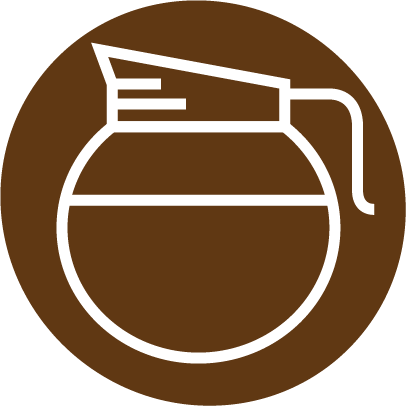 Chromium
Chromium
| Amount Per Serving |
35 mcg |
| %DV |
100% |
Chromium
Daily Requirements (By FDA):
Adults (Men/Women): 35 mcg. Pregnant/Lactating Women: 45 mcg. Children 1-3: 11 mcg [1]
Top 3 Food Sources:
Coffee, Green Beans, Whole-Grains [38]
Deficiency Symptoms:
Rare - Reduced response to sugar, increased risk of diabetes, weight loss, impaired coordination*. [39, 40]
Common Supplement Forms (& Cost):
1. chromium chloride- $
2. chromium nicotinate glycinate chelate- $$
3. chromium picolinate - $ [39]
 Sources chromium nicotinate glycinate chelate, as it is a well-studied natural form. Chromium Chloride in particular has shown to have poor bioavailability (absorbability) [38, 39]
Sources chromium nicotinate glycinate chelate, as it is a well-studied natural form. Chromium Chloride in particular has shown to have poor bioavailability (absorbability) [38, 39]
DIVE DEEPER
Key Functions of Chromium:
An essential trace mineral that can improve insulin sensitivity, and enhance protein and carbohydrate metabolism*. [38]
 Molybdenum
Molybdenum
| Amount Per Serving |
45 mcg |
| %DV |
100% |
Molybdenum
Daily Requirements (By FDA):
Adults (Men/Women): 45 mcg. Pregnant/Lactating Women: 50 mcg. Children 1-3: 17 mcg [1]
Top 3 Food Sources:
Legumes, Whole Grains, Dairy Products[41]
Deficiency Symptoms:
Rare – Typically only impacts people with specific genetic conditions, but can include low blood uric acid, and low urinary uric acid. [42]
Common Supplement Forms (& Cost):
1. molybdenum chloride - $
2. molybdenum glycinate - $
3. molybdenum amino acid chelate - $ [41]
 Sources molybdenum amino acid chelate, as it is a well-studied natural form, although little evidence exists suggesting differences in bioavailability [41]
Sources molybdenum amino acid chelate, as it is a well-studied natural form, although little evidence exists suggesting differences in bioavailability [41]
Key Functions of Molybdenum:
An essential trace mineral that helps break down harmful sulfites, and prevents toxins from building up in your body*. [41]
 Potassium
Potassium
| Amount Per Serving |
100 mg |
| %DV |
2% |
Potassium
Daily Requirements (By FDA):
Adults (Men/Women): 4,700 mg. Pregnant/Lactating Women: 5,100 mg. Children 1-3: 3,000 mg [1]
Top 3 Food Sources:
Bananas, Apricots, Squash [43]
Deficiency Symptoms:
Increased blood pressure, cramps, depleted calcium in bones, and increased risk of kidney stones*. [43]
Common Supplement Forms (& Cost):
1. potassium citrate - $
2. potassium phosphate - $
3. potassium bicarbonate - $ [43]
 Sources potassium bicarbonate, as it aids in the fizzy effervescence in your fizzy drink mix, although little evidence exists suggesting differences in bioavailability between the different forms [43]
Sources potassium bicarbonate, as it aids in the fizzy effervescence in your fizzy drink mix, although little evidence exists suggesting differences in bioavailability between the different forms [43]
Key Functions of Potassium:
An electrolyte that is needed for almost everything your body does, including proper heart & kidney function, muscle contraction, and nerve transmission [43]
 Choline
Choline
| Amount Per Serving |
40 mg |
| %DV |
7% |
Choline
Daily Requirements (By FDA):
Adults (Men/Women): 550 mg. Pregnant/Lactating Women: 550 mg. Children 1-3: 200 mg [1]
Top 3 Food Sources:
Beef Liver, Salmon, Cauliflower [44]
Deficiency Symptoms:
Reduced cognitive function*, muscle and liver damage*. [44]
Common Supplement Forms (& Cost):
1. phosphatidylcholine- $
2. Lecithin - $
3. choline bitartrate- $ [44]
 Sources choline bitartrate, although little evidence exists suggesting differences in bioavailability between the different forms [44]
Sources choline bitartrate, although little evidence exists suggesting differences in bioavailability between the different forms [44]
Key Functions of Choline:
Used by your brain and nervous system to help regulate mood, memory, and muscle control. Also used to help protect your cells by forming membranes around them*. [44]






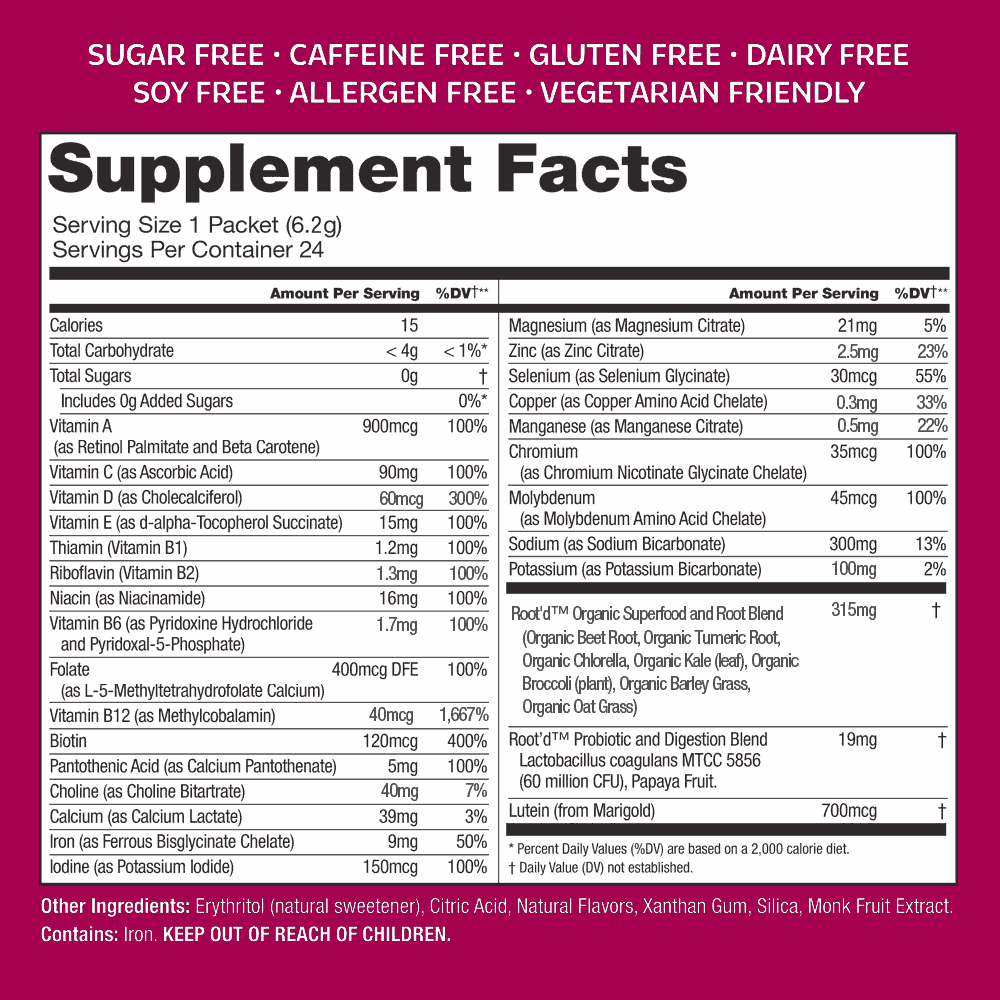

 Vitamin A
Vitamin A
 Vitamin C
Vitamin C
 Vitamin D
Vitamin D
 Vitamin E
Vitamin E
 Vitamin B1
Vitamin B1
 Vitamin B5 (Pantothenic Acid)
Vitamin B5 (Pantothenic Acid)
 Vitamin B6
Vitamin B6
 Vitamin B7 (Biotin)
Vitamin B7 (Biotin)
 Iron
Iron
 Iodine
Iodine
 Selenium
Selenium
 Manganese
Manganese
 Copper
Copper
 Chromium
Chromium
 Molybdenum
Molybdenum
 Potassium
Potassium
 Choline
Choline
